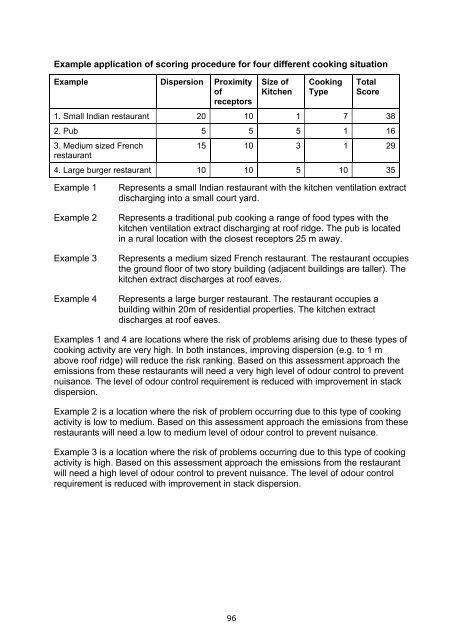Guidance on the Control of Odour and Noise from ... - Defra
Guidance on the Control of Odour and Noise from ... - Defra
Guidance on the Control of Odour and Noise from ... - Defra
Create successful ePaper yourself
Turn your PDF publications into a flip-book with our unique Google optimized e-Paper software.
Example applicati<strong>on</strong> <strong>of</strong> scoring procedure for four different cooking situati<strong>on</strong><br />
Example Dispersi<strong>on</strong><br />
Proximity<br />
<strong>of</strong><br />
receptors<br />
96<br />
Size <strong>of</strong><br />
Kitchen<br />
Cooking<br />
Type<br />
Total<br />
Score<br />
1. Small Indian restaurant 20 10 1 7 38<br />
2. Pub 5 5 5 1 16<br />
3. Medium sized French<br />
restaurant<br />
15 10 3 1 29<br />
4. Large burger restaurant 10 10 5 10 35<br />
Example 1 Represents a small Indian restaurant with <strong>the</strong> kitchen ventilati<strong>on</strong> extract<br />
discharging into a small court yard.<br />
Example 2 Represents a traditi<strong>on</strong>al pub cooking a range <strong>of</strong> food types with <strong>the</strong><br />
kitchen ventilati<strong>on</strong> extract discharging at ro<strong>of</strong> ridge. The pub is located<br />
in a rural locati<strong>on</strong> with <strong>the</strong> closest receptors 25 m away.<br />
Example 3 Represents a medium sized French restaurant. The restaurant occupies<br />
<strong>the</strong> ground floor <strong>of</strong> two story building (adjacent buildings are taller). The<br />
kitchen extract discharges at ro<strong>of</strong> eaves.<br />
Example 4 Represents a large burger restaurant. The restaurant occupies a<br />
building within 20m <strong>of</strong> residential properties. The kitchen extract<br />
discharges at ro<strong>of</strong> eaves.<br />
Examples 1 <strong>and</strong> 4 are locati<strong>on</strong>s where <strong>the</strong> risk <strong>of</strong> problems arising due to <strong>the</strong>se types <strong>of</strong><br />
cooking activity are very high. In both instances, improving dispersi<strong>on</strong> (e.g. to 1 m<br />
above ro<strong>of</strong> ridge) will reduce <strong>the</strong> risk ranking. Based <strong>on</strong> this assessment approach <strong>the</strong><br />
emissi<strong>on</strong>s <strong>from</strong> <strong>the</strong>se restaurants will need a very high level <strong>of</strong> odour c<strong>on</strong>trol to prevent<br />
nuisance. The level <strong>of</strong> odour c<strong>on</strong>trol requirement is reduced with improvement in stack<br />
dispersi<strong>on</strong>.<br />
Example 2 is a locati<strong>on</strong> where <strong>the</strong> risk <strong>of</strong> problem occurring due to this type <strong>of</strong> cooking<br />
activity is low to medium. Based <strong>on</strong> this assessment approach <strong>the</strong> emissi<strong>on</strong>s <strong>from</strong> <strong>the</strong>se<br />
restaurants will need a low to medium level <strong>of</strong> odour c<strong>on</strong>trol to prevent nuisance.<br />
Example 3 is a locati<strong>on</strong> where <strong>the</strong> risk <strong>of</strong> problems occurring due to this type <strong>of</strong> cooking<br />
activity is high. Based <strong>on</strong> this assessment approach <strong>the</strong> emissi<strong>on</strong>s <strong>from</strong> <strong>the</strong> restaurant<br />
will need a high level <strong>of</strong> odour c<strong>on</strong>trol to prevent nuisance. The level <strong>of</strong> odour c<strong>on</strong>trol<br />
requirement is reduced with improvement in stack dispersi<strong>on</strong>.
















